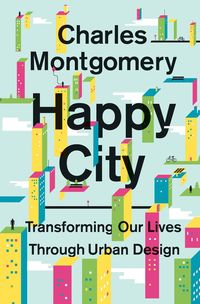The premise behind journalist Charles Montgomery's new book -- Happy City -- is a bold one: That the way we design cities can have a profound impact on well-being and mood -- in essence, personal happiness.
For Happy City, Montgomery worked with experts in the fields of psychology, neuroscience, and behavioral economics to understand the relationship between our environments and our mood. We caught up with him recently to talk about his findings and the mysterious ways in which public spaces interact with human emotion.
Angie Schmitt: What inspired you to write this book?
Charles Montgomery: I was in Mexico City, there seemed to be as much magic and mystery in the heart of the city than I ever felt on a remote island. I attended a conference and got to spend some time with [former Bogota Mayor] Enrique Penalosa. He’s been making these points about happiness in cities for years. I was inspired, but also as a journalist skeptical about this notion that design could inspire happiness.
I started out with this question: What do I mean by happiness? What do any of us mean by happiness? I came to the same conclusion people have been coming to for thousands of years. Each of us defines our happiness differently.
We all agree that it helps to be rich, and successful, and have a big house and a great spouse, but it’s not enough. You need to be engaged with the community.
AS: Did your research compare rural living versus urban living? Or city to city?
CM: I didn’t set up a comparison between cities. I did try to look at how different aspects of cities can make or break happiness by fulfilling our needs. What I did learn is that people report being happiest in cities where social trust is highest. The more you trust strangers, the police, your neighbors, the happier your city.
If you lose your wallet, what are the chances it will be returned to you? It turns out, that is a really good proxy for social trust. Canada’s largest cities tend to be lower trust and so less happy. It was the mid-sized cities -- St. John and St. Johns, those are different cities -- that had the highest levels of trust.
The message is hopeful. What it tells us is if we make changes to our cities, make them more convivial, more connected, we can build happiness into our cities, even if we don’t get rich.
AS: So how does all this relate to design?
CM: There’s a direct relationship with design. We know that people that live on the exurban edge report lower levels of trust. They’re less likely to have dinner with their families, less likely to read newspapers, and even vote, than people who live in mixed-use communities, or old-fashioned communities.
That’s really concerning. Now that America is recovering from the economic crisis and the sprawl project is starting back up.
AS: So sprawl makes people unhappy?
CM: The word is dispersal. The more dispersed we are, the harder it is to connect. It’s not a hard geometry to understand.
AS: So what are the lessons from your book for planners and other designers?
CM: First of all, if we’re entrusted with the well-being of cities, which is contingent on social relationships, we have to keep the potential for design to influence social relationships in the forefront of our decisions. My research suggests that contact -- casual contact -- with neighbors and strangers is just as important as our contact with family and close friends. Every interaction with a stranger in the city can either elicit a stressful or convivial hormonal response.
I spent time with a neuro-economist -- Paul Secada -- he studies oxytocin, it’s a hormone, a neurotransmitter. Women produce it when they give birth, but it’s also produced whenever we have a trust-building interaction. Paul and I spent a morning at Disneyland, bumping into people, dropping my wallet and eventually hugging complete strangers. Landscape itself gives us conscious and unconscious cues about how we should behave.
What’s happening on Main Street USA? First of all, there’s no cars. People can let their children run around. The street has a slow velocity. There’s lots to do and see and people slow down. The street edge did another thing. The top two floors of each building are shrunk to five-eighths scale. They feel unthreatening like toys. What’s happening on that street, you’re getting signals that are reactivating memories. If you see something that is calm or comforting, your brain will return other comforting memories.
People are much happier on a messy, jumbled up block of old tenements than they are on a high-design, pristine but blank block.






